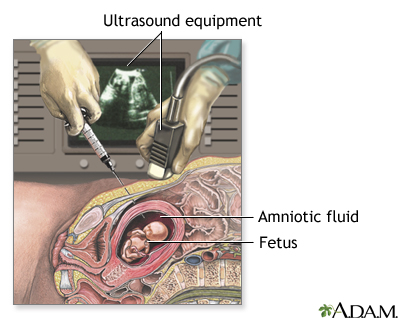
Overview
Amniocentesis is done in an examination room, either with or without local anesthesia. It typically takes just a few minutes, during which you must lie very still. A technician locates your fetus with an ultrasound. Using the ultrasound for guidance, your doctor carefully inserts a long, but thin, hollow needle through your abdomen and into the amniotic sac. You should receive Rh immune globulin (RHIG) at the time of amniocentesis if you are an Rh-negative unsensitized patient.
Review Date 8/23/2023
Updated by: LaQuita Martinez, MD, Department of Obstetrics and Gynecology, Emory Johns Creek Hospital, Alpharetta, GA. Also reviewed by David C. Dugdale, MD, Medical Director, Brenda Conaway, Editorial Director, and the A.D.A.M. Editorial team.


